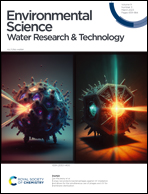Low strength and COD/N wastewater treatment via controlled nitrification by a membrane aerated biofilm, partial denitrification by activated sludge, and anaerobic ammonia oxidation by granular sludge
Abstract
A hybrid process of controlled nitrification by a membrane aerated biofilm (MAB), partial denitrification (PD) by activated sludge, and anaerobic ammonia oxidation (ANAMMOX) by granular sludge was proposed for synthetic low strength and COD/N wastewater treatment to address the challenges of stable nitritation and limited carbon source for nitrogen removal in this study. Batch tests with different aeration pressures showed that MAB achieved an ammonia–nitrogen removal of around 57% and nearly full nitrification under aeration pressure of 6 kPa and reaction time of 9 h, resulting in appropriate conditions for subsequent PD and ANAMMOX. Batch tests with different COD/N ratios revealed that PD activated sludge achieved an average 88% conversion from nitrate to nitrite and a nitrite–nitrogen production rate of 1.24 mg L−1 min−1 under the optimal initial COD/N of 3.5 and MLVSS of 1.3 g L−1. Batch tests on ANAMMOX showed a nitrite–nitrogen consumption rate of 0.13 mg L−1 min−1 under granular sludge MLVSS of 13 g L−1. Furthermore, batch tests mixing PD activated sludge and ANAMMOX granular sludge demonstrated an optimal seeding sludge weight ratio of 1 : 10 for simultaneous nitrate and ammonia removal. Finally, the hybrid process of controlled nitrification by MAB, PD by activated sludge, and ANAMMOX by granular sludge was established to treat synthetic low strength and COD/N wastewater (COD of 175 mg L−1, ammonia–nitrogen of 100 mg L−1). After 10 cycles of operation with a reaction time of 9 h, the effluent ammonia–nitrogen decreased to below 10 mg L−1, nitrate and nitrite nitrogen were below 3 mg L−1, and COD was below 50 mg L−1, achieving simultaneous carbon and nitrogen removal capacity of 0.36 gCOD L−1 d−1 and 0.23 gN L−1 d−1, respectively.



 Please wait while we load your content...
Please wait while we load your content...